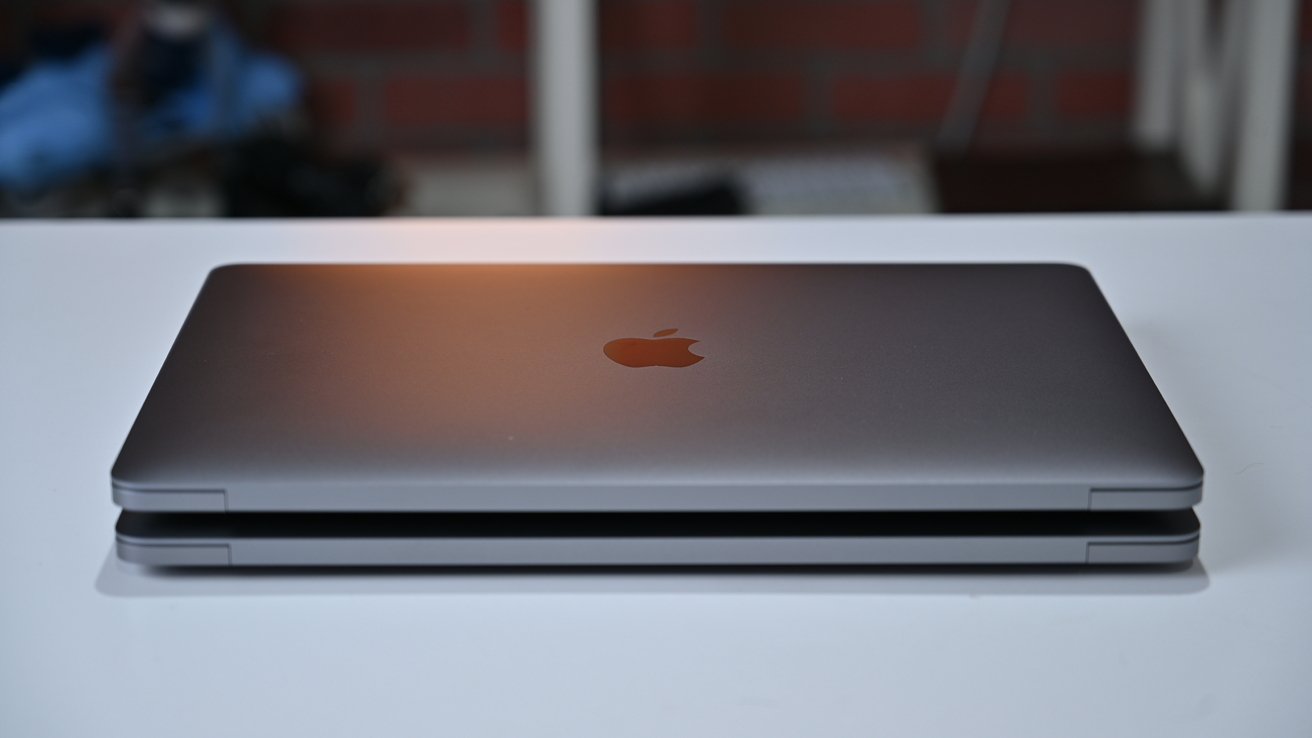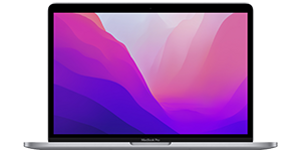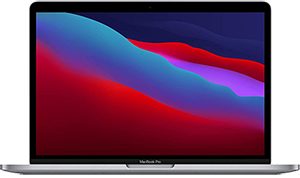The new 13-inch MacBook Pro with an M2 chipset is in our video studio. There's a lot internally to compare, including graphics, processor, and a slower SSD on the new model.

A pair of stacked 13-inch MacBook Pros
The 13-inch MacBook Pro received a modest refresh at the company's WWDC 2022 keynote on June 6. Unlike other Apple Silicon models, the 13-inch MacBook Pro didn't receive a major redesign or significant new features beyond the M2.
Here's how the new Mac differs from its predecessor.
M2 13-inch MacBook Pro versus M1 13-inch MacBook Pro: Specifications
| 13-inch MacBook Pro, M1 | 13-inch MacBook Pro, M2 | |
|---|---|---|
| Display Size (inches) | 13.3 | 13.3 |
| Max Resolution | 2560 x 1600 | 2560 x 1600 |
| Pixel Density | 227 | 227 |
| Brightness | 500 nits | 500 nits |
| Display Backlighting | LED | LED |
| Display Technology | Wide Color (P3), True Tone | Wide Color (P3), True Tone |
| Processors | Eight-core Apple M1 | Eight-core Apple M2 |
| Memory | 8GB or 16GB Unified Memory | 8GB, 16GB, or 24GB Unified Memory |
| Graphics (integrated) | Eight-core Apple Silicon M1 | 10-core Apple Silicon M2 |
| External Video | 1 6K display at 60Hz | 1 6K display at 60Hz |
| Storage | 256GB, 512GB, 1TB, 2TB | 256GB, 512GB, 1TB, 2TB |
| Touch Bar | Yes | Yes |
| Biometrics | Touch ID | Touch ID |
| Trackpad | Force Touch | Force Touch |
| Keyboard | Backlit with ambient light sensor | Backlit with ambient light sensor |
| Dimensions (inches) | 0.61 x 11.97 x 8.36 | 0.61 x 11.97 x 8.36 |
| Weight (pounds) | 3.0 | 3.0 |
| Battery Life | 20 Hours | 20 Hours |
| Ports | 2 USB 4 / Thunderbolt 3 ports, Headphone jack | 2 USB 4 / Thunderbolt 3 ports High-impedance headphone jack |
| Webcam | 720p FaceTime HD | 720p FaceTime HD Advanced image signal processor |
| Speakers | Stereo speakers with high dynamic range | Stereo speakers with high dynamic range |
| Microphones | 3 with directional beamforming | 3 with directional beamforming |
| Wi-Fi | Wi-Fi 6 | Wi-Fi 6 |
| Bluetooth | 5.0 | 5.0 |
| Charger | 61W USB-C | 67W USB-C |
| Color Options | Silver, Space Gray | Silver, Space Gray |
| Price | From $1,299 | From $1,299 |
M2 13-inch MacBook Pro versus M1 13-inch MacBook Pro: Processor
The 13-inch MacBook Pro, which was last refreshed in 2020, now sports an upgraded M2 processor instead of the previous-generation M1. The inclusion of the M2 is by far the most significant difference between the two models.
Like the M1, the Apple M2 is based on a 5nm chipmaking process. However, the M2 packs 4 billion more transistors than its predecessor. The core count, on the other hand, remains the same at 8 -- with four performance cores and four efficiency cores.
The M2 also supports up to 24GB of Unified LPDDR5 memory, while the M1 was capped at 16GB. Unified memory bandwidth is now 100 GBps, about 50% more than the M1.
Our testing shows that the M2 chip is roughly 18% faster than the M1 when it comes to standard CPU performance, which aligns with Apple's claims. Because the core count is the same, those gains are likely because of architecture improvements.
The M2 in the 13-inch MacBook Pro outperforms the M1 model easily in benchmark tests.
Geekbench 5 results on the M2 MacBook Pro
In single-core Geekbench 5 testing, the M2 chip received a score of 1928. The same chip got a multi-core Geekbench score of 8990. For comparison, a late 2020 MacBook Pro with an M1 chip received a single-core score of 1749 and a multi-core score of 7719.
M2 13-inch MacBook Pro versus M1 13-inch MacBook Pro: Graphics
When it comes to graphical performance, Apple has bumped up the GPU core count on the M2. The chip sports a 10-core integrated GPU instead of the 8-core graphics processor in the M1.
Overall, the new M2 GPU is about 35% faster than the graphics processor in the M1. That's likely because of the additional GPU cores, as well as other enhancements.
Exporting video with the new MacBook Pro
When it comes to specific graphical tasks, users may notice a slightly bigger bump to performance. Apple says playing graphically intensive games like Baldur's Gate 3 is nearly 40% faster than the M1-based MacBook Pro.
Users who work with RAW images in Affinity Photo will find that their workflows are also about 40% faster than on the previous 13-inch MacBook Pro model.
The 13-inch MacBook Pro also now supports ProRes encode and decode in the media engine. Apple says that will allow it to play back up to 11 streams of 4K video or up to two streams of 8K ProRes video. Video projects can be converted to ProRes nearly three times faster.
When we tested a non-ProRes video export, we didn't see much of a difference. Exporting a 20-minute 4K video took just under ten minutes for the M2 while it took our M1 ten minutes and 14 seconds.
M2 13-inch MacBook Pro versus M1 13-inch MacBook Pro: Design & physical differences
Even though the new 13-inch MacBook Pro may have a more powerful chip on the side, you'd be hard-pressed to tell the difference between the M1 model and the M2 model. Some tasks, like video editing, is notably faster thanks to the inclusion of Apple's more advanced Media Engine absent in the M1.
Both 13-inch MacBook Pro models are essentially identical when it comes to physical form factor. They share the same overall dimensions and weight.
The M2-based MacBook Pro also retains the Touch Bar, making it the only Mac in Apple's current lineup to have the feature.
M2 13-inch MacBook Pro versus M1 13-inch MacBook Pro: Display & Camera
Both of the 13-inch MacBook Pro models have the same exact camera -- an aging 720p FaceTime HD camera. The M2 model also retains the same three-mic array as its predecessor had.
However, the updated image signal processor in the M2 chip could still result in slightly better video call performance. Apple says the ISP can improve exposure levels, white balance, and noise reduction automatically.
The cameras are the same on both models, but the M2 has an updated signal processor that could lead to slight video improvements.
The display is also the same. It's a 13.3-inch LED-backlit display with IPS. It has a resolution of 2560 x 1600 at 227 pixels per inch, True Tone, and 500 nits of maximum brightness.
M2 13-inch MacBook Pro versus M1 13-inch MacBook Pro: Ports & Connectivity
Both models have a pair of USB4 / Thunderbolt 3 ports that support a range of capabilities, from DisplayPort to Thunderbolt data transfer at speeds up to 40Gb/s. There's also a headphone jack on both models, but the new model has specific support for high-impedance headphones.
13-inch MacBook Pro
There haven't been any wireless connectivity-related upgrades either. The M2 and M1 MacBook Pro models both support Bluetooth 5.0 and Wi-Fi 6, also known as 802.11ax.
If you want to connect your device to an external display, just note that the M2-based 13-inch MacBook Pro still only supports a single external display. It can connect to one display with up to a 6K resolution at 60Hz.
Somewhat related to these hardware changes, Apple did modify the SSD on the base 256GB model. The M2 MacBook Pro has a slower SSD included on this entry-level unit though the higher-capacity options retain their speed.
On our 256GB M1 13-inch MacBook Pro, we were getting roughly 2900 MB/s for write speeds and 2200 MB/s for read speeds. Conversely, the new 256GB M2 13-inch MacBook Pro only is getting 1464 MB/s on the write speed and 1446 MB/s for the read speed.
M2 13-inch MacBook Pro versus M1 13-inch MacBook Pro: Other features
The list of miscellaneous features on both the M2- and M1-based 13-inch MacBook Pro are virtually identical.
Both models come in Silver and Space Gray, both have the same keyboard and trackpad, and both keep the same starting price of $1,299.
One major difference between the M1 and M2 models is the speakers. While both use stereo speakers, the M2 model supports Spatial Audio which can add a 3D effect for some audio tracks.
Additionally, the M2 13-inch MacBook Pro comes with a 67W charging brick instead of the 61W power adapter included with the M1 variant.


